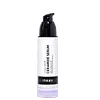What's inside
What's inside
 Key Ingredients
Key Ingredients

 Benefits
Benefits

 Concerns
Concerns

 Ingredients Side-by-side
Ingredients Side-by-side

Water
Skin ConditioningButylene Glycol
HumectantGlycerin
HumectantSodium Hyaluronate
HumectantSimmondsia Chinensis Seed Oil
EmollientCarbomer
Emulsion StabilisingPhenoxyethanol
PreservativeHydroxyethyl Acrylate/Sodium Acryloyldimethyl Taurate Copolymer
Emulsion StabilisingBenzyl Alcohol
PerfumingSqualane
EmollientSodium Lauroyl Lactylate
EmulsifyingSodium PCA
HumectantSodium Hydroxide
BufferingSodium Stearoyl Glutamate
CleansingSodium Lactate
BufferingArginine
MaskingAspartic Acid
MaskingEthylhexylglycerin
Skin ConditioningSodium Gluconate
Skin ConditioningPCA
HumectantPolysorbate 60
EmulsifyingDehydroacetic Acid
PreservativeCeramide NP
Skin ConditioningGlycine
BufferingAlanine
MaskingSorbitan Isostearate
EmulsifyingCeramide AP
Skin ConditioningPhytosphingosine
Skin ConditioningSerine
MaskingCholesterol
EmollientValine
MaskingXanthan Gum
EmulsifyingIsoleucine
Skin ConditioningProline
Skin ConditioningThreonine
Histidine
HumectantPhenylalanine
MaskingCeramide EOP
Skin ConditioningWater, Butylene Glycol, Glycerin, Sodium Hyaluronate, Simmondsia Chinensis Seed Oil, Carbomer, Phenoxyethanol, Hydroxyethyl Acrylate/Sodium Acryloyldimethyl Taurate Copolymer, Benzyl Alcohol, Squalane, Sodium Lauroyl Lactylate, Sodium PCA, Sodium Hydroxide, Sodium Stearoyl Glutamate, Sodium Lactate, Arginine, Aspartic Acid, Ethylhexylglycerin, Sodium Gluconate, PCA, Polysorbate 60, Dehydroacetic Acid, Ceramide NP, Glycine, Alanine, Sorbitan Isostearate, Ceramide AP, Phytosphingosine, Serine, Cholesterol, Valine, Xanthan Gum, Isoleucine, Proline, Threonine, Histidine, Phenylalanine, Ceramide EOP
Goat Milk Extract
Cyclopentasiloxane
EmollientPEG-10 Dimethicone
Skin ConditioningButylene Glycol
HumectantGlycerin
HumectantWater
Skin Conditioning1,2-Hexanediol
Skin ConditioningNiacinamide
SmoothingAdenosine
Skin ConditioningHydrolyzed Collagen
EmollientSodium Hyaluronate
HumectantTricholoma Matsutake Extract
Skin ConditioningLactose
HumectantPersea Gratissima Fruit Extract
EmollientPropolis Extract
Skin ConditioningHydrogenated Lecithin
EmulsifyingLinoleic Acid
CleansingCeramide NP
Skin ConditioningTea-Cocoyl Glutamate
CleansingCaprylic/Capric Triglyceride
MaskingCamellia Japonica Seed Oil
EmollientTitanium Dioxide
Cosmetic ColorantSodium Chloride
MaskingCetyl PEG/PPG-10/1 Dimethicone
EmulsifyingEthylhexylglycerin
Skin ConditioningCI 77492
Cosmetic ColorantCI 77491
Cosmetic ColorantZinc Oxide
Cosmetic ColorantCI 77499
Cosmetic ColorantTriethoxysilylethyl Polydimethylsiloxyethyl Hexyl Dimethicone
Skin ConditioningUltramarines
Hydrogen Dimethicone
Triethoxycaprylylsilane
Parfum
MaskingGoat Milk Extract, Cyclopentasiloxane, PEG-10 Dimethicone, Butylene Glycol, Glycerin, Water, 1,2-Hexanediol, Niacinamide, Adenosine, Hydrolyzed Collagen, Sodium Hyaluronate, Tricholoma Matsutake Extract, Lactose, Persea Gratissima Fruit Extract, Propolis Extract, Hydrogenated Lecithin, Linoleic Acid, Ceramide NP, Tea-Cocoyl Glutamate, Caprylic/Capric Triglyceride, Camellia Japonica Seed Oil, Titanium Dioxide, Sodium Chloride, Cetyl PEG/PPG-10/1 Dimethicone, Ethylhexylglycerin, CI 77492, CI 77491, Zinc Oxide, CI 77499, Triethoxysilylethyl Polydimethylsiloxyethyl Hexyl Dimethicone, Ultramarines, Hydrogen Dimethicone, Triethoxycaprylylsilane, Parfum
 Reviews
Reviews

Ingredients Explained
These ingredients are found in both products.
Ingredients higher up in an ingredient list are typically present in a larger amount.
Butylene Glycol (or BG) is used within cosmetic products for a few different reasons:
Overall, Butylene Glycol is a safe and well-rounded ingredient that works well with other ingredients.
Though this ingredient works well with most skin types, some people with sensitive skin may experience a reaction such as allergic rashes, closed comedones, or itchiness.
Learn more about Butylene GlycolCeramide NP is a type of ceramide and formally known as ceramide 3.
Ceramides are intercellular lipids naturally found in our skin that bonds dead skin cells together to create a barrier. They are known for their ability to hold water and thus are a great ingredient for dry skin.
Ceramides are an important building block for our skin barrier. A stronger barrier helps the skin look more firm and hydrated. By bolstering the skin ceramides act as a barrier against irritating ingredients. This can help with inflammation as well.
If you would like to eat ceramides, sweet potatoes contain a small amount.
Read more about other common types of ceramides here:
Ceramide AP
Ceramide EOP
Ethylhexylglycerin (we can't pronounce this either) is commonly used as a preservative and skin softener. It is derived from glyceryl.
You might see Ethylhexylglycerin often paired with other preservatives such as phenoxyethanol. Ethylhexylglycerin has been found to increase the effectiveness of these other preservatives.
Glycerin is already naturally found in your skin. It helps moisturize and protect your skin.
A study from 2016 found glycerin to be more effective as a humectant than AHAs and hyaluronic acid.
As a humectant, it helps the skin stay hydrated by pulling moisture to your skin. The low molecular weight of glycerin allows it to pull moisture into the deeper layers of your skin.
Hydrated skin improves your skin barrier; Your skin barrier helps protect against irritants and bacteria.
Glycerin has also been found to have antimicrobial and antiviral properties. Due to these properties, glycerin is often used in wound and burn treatments.
In cosmetics, glycerin is usually derived from plants such as soybean or palm. However, it can also be sourced from animals, such as tallow or animal fat.
This ingredient is organic, colorless, odorless, and non-toxic.
Glycerin is the name for this ingredient in American English. British English uses Glycerol/Glycerine.
Learn more about GlycerinSodium Hyaluronate is hyaluronic acid's salt form. It is commonly derived from the sodium salt of hyaluronic acid.
Like hyaluronic acid, it is great at holding water and acts as a humectant. This makes it a great skin hydrating ingredient.
Sodium Hyaluronate is naturally occurring in our bodies and is mostly found in eye fluid and joints.
These are some other common types of Hyaluronic Acid:
Learn more about Sodium HyaluronateWater. It's the most common cosmetic ingredient of all. You'll usually see it at the top of ingredient lists, meaning that it makes up the largest part of the product.
So why is it so popular? Water most often acts as a solvent - this means that it helps dissolve other ingredients into the formulation.
You'll also recognize water as that liquid we all need to stay alive. If you see this, drink a glass of water. Stay hydrated!
Learn more about Water